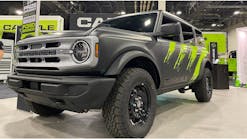New vehicle technologies developed by OEMs will continue to challenge both the technical skills and financial acumen of the collision repair industry. That was the message delivered by Bill Haas, vice president of education and training at the Automotive Service Association, during his Wednesday morning session at NACE, "New Vehicle Technology – Arriving at Your Shop Soon!"
During the presentation, Haas discussed technologies that have already arrived in current vehicle models, and those that repairers will begin seeing several years from now, including everything from vehicle systems that interface with smartphones, to new materials used in vehicle construction.
"The impact of these things on the shop will be huge, especially from a training standpoint," Haas said. "I'm only presenting all this information in hopes of creating a greater awareness so shops realize that training is going to be key to their survival, to their future."
With even more technology added to new vehicles, it will be more challenging and expensive to repair systems damaged in a collision. Some of the technology already in existence includes alcohol detection systems that can prevent drivers from operating vehicles while intoxicated, direct shift gearboxes in the drive train, carbon ceramic brakes and touchscreen dashboards.
Yet to arrive are hydrogen fuel systems, which are already being beta tested in some markets. "Those vehicle are so new, and in such limited production quantities, that collision repair services are included in the lease," Haas said. "The manufacturers want to see what happens when these cars are damaged in a collision. How does that impact the internal systems?"
Selective catalytic reduction systems for diesel engines may also pose a repair challenge. The fluids used to reduce nitrogen oxide emissions in diesel exhaust utilize a fluid made from purified water and medical-grade urea. "Today there is nothing known that can remove the stain made by that solution if it gets on the interior of the vehicle during an accident," Haas said. "Now collision repair facilities have to be prepared for that becoming part of an estimate, because it can't be cleaned."
One technology that could have a more wide-reaching impact on the collision industry is vehicle-to-vehicle communication systems that can prevent collisions.
"These systems will be able to notify a driver of a vehicle in their blind spot," Haas said. "The systems can put messages on the dashboard, or even take over control of the vehicle and apply the brakes if the vehicle approaches another vehicle within a certain distance. We'll be looking at fewer collisions, and the impact of that will be huge."
Added technology also will inflate the cost of repairs, and potentially lead to more total losses. "If you have to spend a few hundred dollars per module when these systems are damaged in a collision, that has a huge impact on the cost of the repair and when you reach the threshold of reparability," Haas said.
That's why training will be especially important, so that collision shops are equipped to repair those vehicles that do make it into the facility. In some cases, shops may specialize in certain OEM brands to reduce their equipment expenses.
"The attitude of the shop will determine if they are going to make the commitment in training and the investment in tools and equipment to keep up," Haas said. "Your job is going to be easier by being prepared. If you're not prepared, that's when the job becomes difficult."


